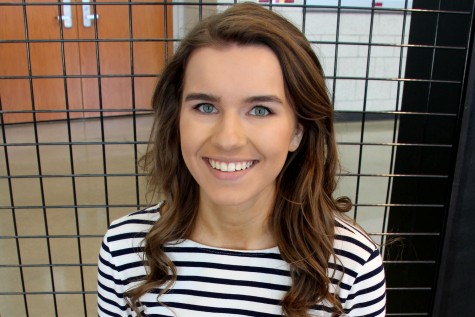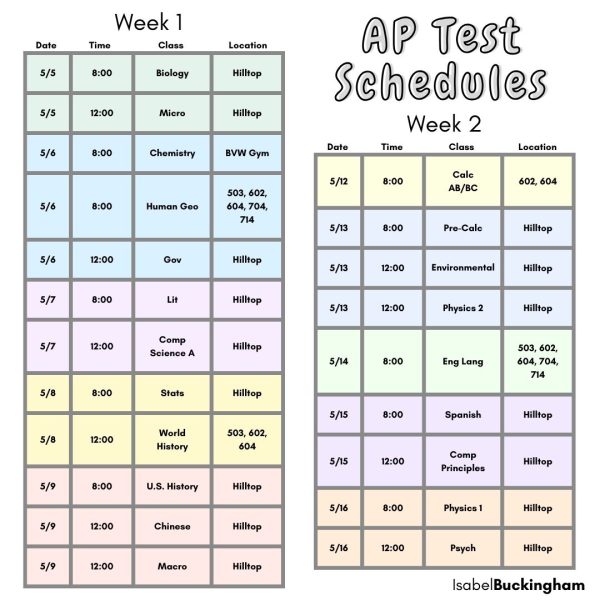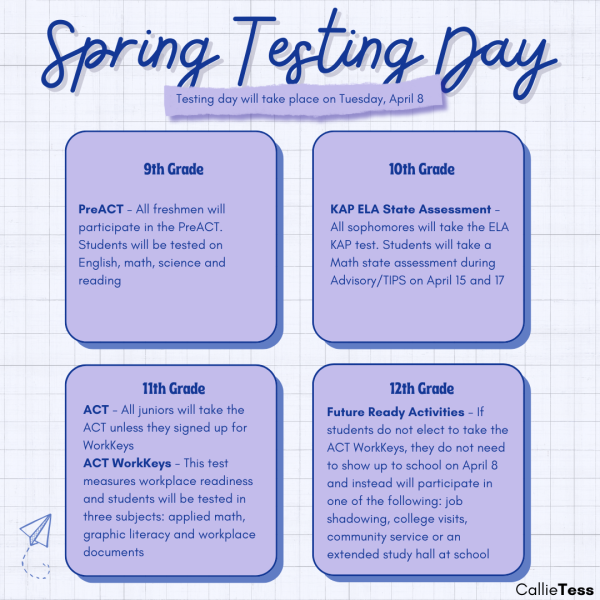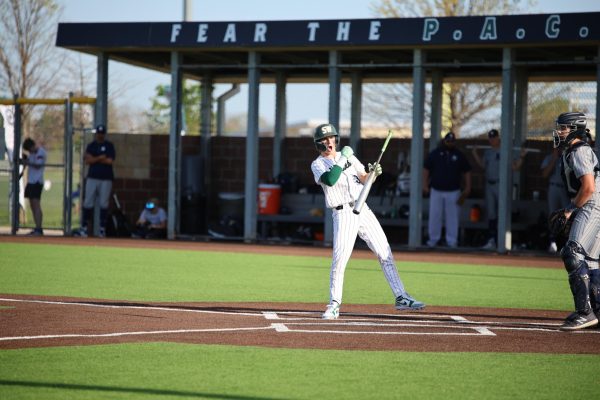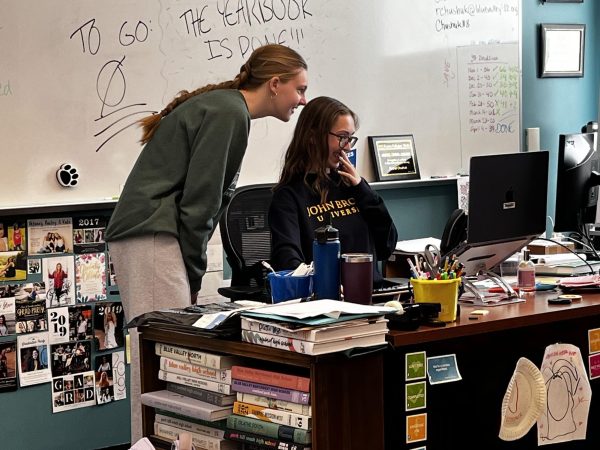Administrators implement new lunchroom policy after incidents of vandalism
Every afternoon, juniors Madison Moore and Madison Ruffalo go to four hours of swim practice. By the time they get home, shower and eat dinner, their day’s worth of homework is often started close to 9 p.m.. In an effort to balance homework and sleep, Moore and Ruffalo utilized their lunch period to alleviate their homework load for that night. However, after incidents of vandalism and messes repeatedly occurred and became a more frequent problem throughout first semester, administrators implemented a new lunchroom policy that tightened restrictions on where students are able to eat during the lunch period.
“It’s really frustrating because sometimes when I’m going through my list [of homework] before I go to bed I’ll be like, ‘Oh, I can do that during lunch — it’s no big deal,’ but now that’s not an option anymore,” Ruffalo said. “I’m not the only one who used the library during lunch time, so me and all the other people were trying to be good, but we’re feeling the heat more from [the policy].”
The new policy took effect the first day of second semester, Monday, Jan. 5. Students had previously been able to eat lunch in other parts of the building, including the library, classrooms and flex spaces, but under the new lunchroom policy, all students are required to stay in the commons during the lunch period.
“When we saw trash down [in the hallway] and we saw food on the walls, we thought, ‘OK, we’re going to correct it because somebody is taking advantage of us,’” Assistant Principal and Athletic Director Gary Howard said. “For somebody that’s been here for five years and appreciates what we have and wants to keep everything nice for the next kids that come through, that hurts me. If I can do something to correct it, then I’m going to do it.”
The custodial staff would commonly find lunch trays not returned to the cafeteria left in other parts of the building, trash on the floor, spilled food, lunch trays in the trash cans and other messes, including food thrown against the wall. Custodians also encountered messes left in the bathroom.
Video footage revealed that the majority of the incidents occurred during the lunch period when kids were not eating in the commons. This led Howard, the custodians, school resource officers (SROs), counselors and other administrators to the proposition of a new lunchroom policy that would include locking doors to hallways exiting the lunchroom and tightening supervision to ensure all students stayed in the commons during their allotted lunch time.
“The simplest thing to do is to eat in the lunch area, and that way, if you make a mess in the lunchroom, it falls on the concrete and it takes probably five or 10 minutes [to clean up], and it’s no big deal,” Howard said. “If you come down here [in the flex spaces] and nobody is supervising you, and you find applesauce on the side of the wall, how would that make you feel? It hurts. I would imagine that most kids, if they saw what was going on, would correct it themselves, but unfortunately, some of the kids are doing it when nobody else is around.”
Messes composed of food weren’t the only issues that led Howard and other administrators to implement the new policy. Thermostats were found torn off walls, paper towel dispensers were found on the floor, locker doors were bent, bathroom mirrors were broken and students were discovered smoking e-cigarettes in the bathrooms — all on numerous occasions. Video surveillance again revealed that a common factor was found among the incidents — they were occurring during the lunch period.
“We used to be pretty liberal about leaving doors unlocked, and it just got to the point where too many bad things were happening during the lunch period because everybody’s main focus is in [the commons], so then a lot of the kids were wandering the halls unsupervised,” SRO Lance Balderston said. “[Vandalism] is progressively getting worse. It’s not epic, but it’s gotten worse over the years.”
According to the Pocket Guide to Kansas Criminal Law, which Balderston and fellow SRO Matt Buelt follow, vandalism is defined as “knowingly damaging, destroying, defacing or substantially impairing the use of any property in which another has an intent without consent of such other person.” Once destruction of property is discovered, Balderston and Buelt file a criminal damage to property report and send it to the Johnson County District Attorney’s office, along with information surrounding the suspect of the vandalism.
Vandalism is divided into two categories — misdemeanor, which includes crimes under $1,000, and felony, which covers crimes over $1,000. The cost of the property combined with the cost of repair comprises the total charge that would either fall under a misdemeanor or felony. School administrators and the district court can be involved in deciding upon a punishment for the perpetrator, which can range from suspension to court-ordered community service.
“It seems that the kids just don’t respect each other or their property or their school,” Balderston said. “I don’t know if that’s a wave of what we’re getting from the new kids or the freshmen that are moving in from other schools, but it just seems like it’s kind of gone — the respect for each other and each other’s properties.”
While food messes in the hallways aren’t filed in criminal reports, they don’t go unpunished. Incidents classified under disorderly conduct can also result in in-school and out-of-school suspensions. Disorderly conduct is often handled at the administrator level, and its cleaning can be just as burdensome for the custodians as incidents filed under criminal reports.
When custodians encounter messes in their designated areas of the school, they are expected to clean up the mess during their eight-hour shifts. However, if the shift ends before the mess can be properly cleaned up, a custodian working the next rotation will take over cleaning the area. If the custodians do not have the appropriate cleaning supplies readily available at their home high school, they contact Executive Director of Facilities and Operations Dave Hill and Director of Operations and Maintenance Dave Peterson at District Office. District Office can provide external cleaning supplies, such as heavy duty washers, and also handles reports surrounding broken property and provides new equipment to replace what was damaged.
“We strive for a very quick response,” Hill said. “The goal is to not give anyone that might have done the vandalism the satisfaction of the message or the shock value that they were intending to create by doing it in the first place. It’s unfortunate when custodians need to take time out of their normal routines to address [vandalism], but we recognize that’s part of providing custodial services for a high school.”
Messes in the flex spaces and classrooms have created challenges for the custodial staff and Howard, as the carpet poses a difficult cleaning duty. While the trashcans in the lunchroom are emptied immediately after lunch and the floors are washed with a wet squeegee daily, trash cans in other parts of the building can sometimes go unemptied for 24 to 48 hours. Therefore, even properly disposed food can attract insects, mice and other rodents.
“[Lunch] is a time not to go out in different parts of the building,” Howard said. “We’ve been a little bit lax in doing that, and the majority of the kids can handle it, but what [other kids] do is they see some kids taking food to a classroom to eat, and they’re saying, ‘Why do they get to do that?’ And then all of a sudden, instead of all the kids eating in the lunchroom, you have kids eating in the halls and down in the flex classrooms. If you let 10 kids, then you better let 260 kids go anywhere they want. There has to be some supervision in what we do.”
The new lunchroom policy may decrease vandalism and mess issues, but it’s also unintentionally affected students who used the lunch period to work on homework in the library or socialize with their friends in a supervised classroom. WolfByte crew members had taken pride in their tradition of listening to music and spending time as a crew in the WolfByte classroom during lunch. Even after being restricted to eating in the WolfByte classroom only twice a week first semester, adjusting to eating solely in the lunchroom was a big transition for WolfByte Executive Producer senior Mads Carrigan, who had eaten in the WolfByte room every day since she joined the crew last spring.
“The first couple of days [that the policy was enforced], we had no idea where to go or who to sit with,” Carrigan said. “There are no full tables where we can all sit down together because by the time we get there and everybody gets their food, they’re all taken, so we can’t even continue our tradition in the lunchroom because there are 19 of us. Our tradition has been completely cut off.”
While Howard said the new policy has unfairly penalized those not responsible for the issues leading to its implementation, he said that students should spend their lunch period taking a break from the stresses of school — and do so in the lunchroom.
“The classrooms aren’t a place for kids to eat,” Howard said. “For that 25 minutes that you have during [lunch], that’s your time. You should be able to sit up in the commons across from one of your friends and visit. That’s 25 minutes of your time when you need a break during the day.”
While the effectiveness of the new lunchroom policy is currently in the ‘wait and see’ period, Howard doesn’t expect the lunchroom policy will ever go back to being as liberal as it once was. The typical lunch period serves around 260 to 270 students, but with numbers expecting to grow to as much as 400 students per lunch period, Howard said restrictions on allowing students to leave the commons are needed to protect the conditions of the school.
“I’m passionate for the kids, and I’m passionate about this building,” Howard said. “I’ll want the next generation to be able to experience the same [conditions of the school]. We are very fortunate to have this building, and I want it to be as nice in 10 years when kids come in [as it is now].”



